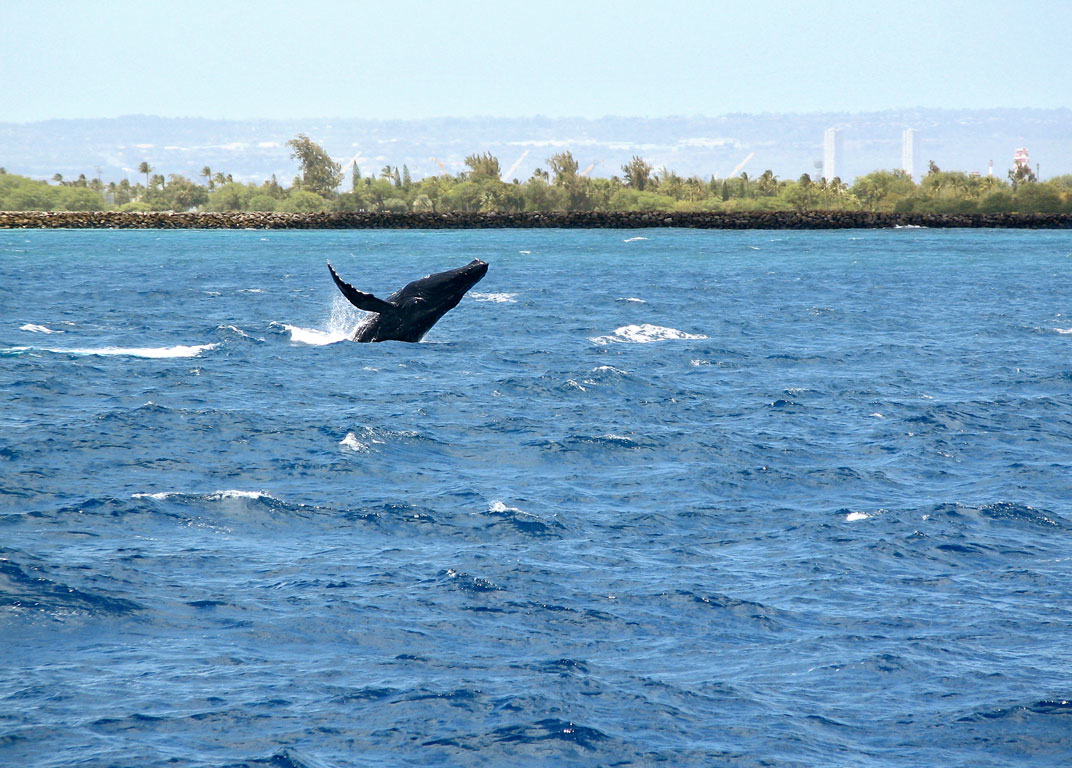Published in the Ocean Watch column, Honolulu Star-Advertiser © Susan Scott
October 10, 2011
Our humpback whales are back. Well, at least three are back, one spotted Sept. 26 off the Kona Coast and two more seen last week near Lanai. The rest of their cohorts will arrive from Alaska within the next month or two.
They will not, however, all be here at the same time.
 Photo by Scott Davis
Photo by Scott Davis
Humpback whale breaching off Oahu.
Most humpback whales migrating to Hawaii come from Alaska waters, about 3,500 miles away. Averaging 4 to 6 mph, the whales make the journey in 28 to 39 days. Then they turn around and swim back to feast in the Arctic’s plankton-rich waters.
This annual round-trip journey is mind-boggling enough, but even more mind-boggling is the observation that some of our whale visitors barely catch their breath before they’re off again.
Researchers believe that most whales do not spend the entire winter in Hawaii. Data reveal that the average humpback spends a month to six weeks here with a few individuals sticking around for as little as three weeks. So as some whales are just arriving in Hawaii, others are already leaving.
Everyone knows that spending a few winter weeks in Hawaii is worth some effort. But swimming 7,000 miles for a three-week visit seems ridiculous. Why do the whales do that?
In a word, sex. It appears that humpback whales spend this extraordinary amount of energy to migrate for only one reason: to procreate. All the humpback whale behaviors we see in Hawaii relate to each whale’s drive to pass on its genes and, in some male’s cases, to prevent others from passing on theirs.
Exactly why humpbacks leave food-rich areas to court, compete, mate and give birth in warm waters over shallow banks is not known. It must, though, have some reproductive advantage. Ten of the 11 humpback whale populations of the world migrate from cold water to warm and back again annually. The exception is a pod off Oman that does not migrate at all.
Humpback whales have a marching order to their migrations. With some overlap, females with yearlings arrive in Hawaii first, immature whales come next, mature females follow, then mature males. Last come females in late pregnancy.
The sequence in which the whales leave Hawaii is less clear. All those that stay for more than two months are males. One male stayed for three months, the longest visit recorded so far. The longest a female has remained in Hawaii has been seven weeks.
Some females don’t make the trip at all. One guess as to why a mature female doesn’t show up in Hawaii is that she’s taking a year of rest. Another theory is that when a female gets pregnant on her way to Hawaii, she turns around and goes back.
These hypotheses are questionable, though, because when males are in the majority in Hawaii, females are not in the majority in Alaska. The case of the missing females is still unsolved.
There’s a lot left to learn about our whales’ migrations. Who knows? In a week or two, that first whale sighted off Kona may already be heading home.